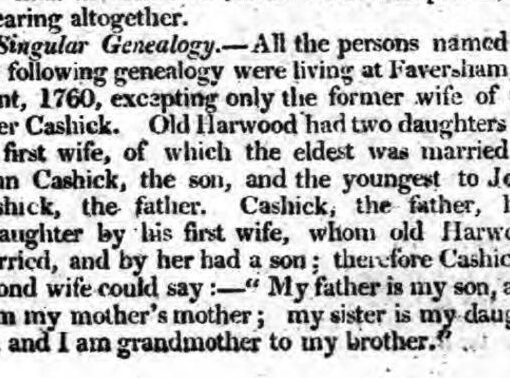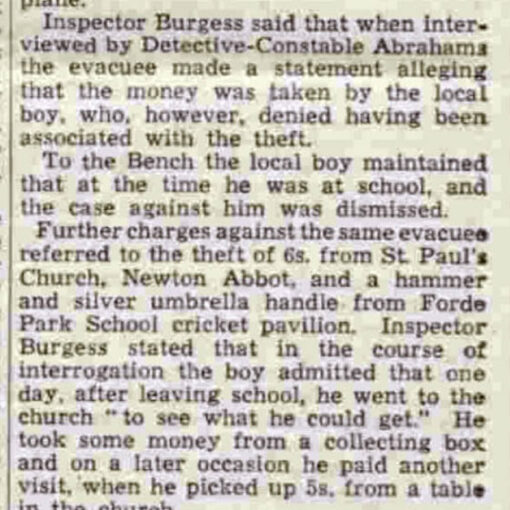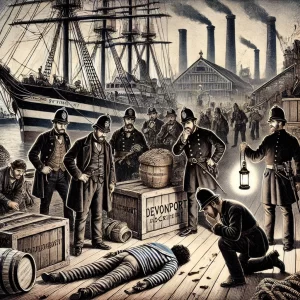Bath Chronicle and Weekly Gazette – Thursday 31 March 1842

SOMERSETSHIRE SPRING SESSIONS
The following are the names of the prisoners tried at these Sessions, with the nature of the offences, and the result of the trials:
Felonies:
Transportation—For Life:
- George Gullick, an old offender, for stealing a lantern, the property of Jacob Shore.
Fifteen Years:
- George Rogers and Benjamin Rogers, for stealing a wether sheep, the property of Samuel Reynolds. There were several other indictments against the prisoners.
Fourteen Years:
- Sarah Rogers, for receiving the articles stolen by George and Benjamin Rogers.
Ten Years:
- John Padfield, an old offender, for stealing a greatcoat, the property of Henry Allen.
- John Wallis, an old offender, for stealing a copper pot, the property of Thomas Waters.
- Adolphus Denham, for stealing a Bible, the property of Thomas Channing.
- Andrew Yeates, for stealing lead and fixtures, the property of Messrs. Bailey and Williams.
- Thomas Gray, an old offender, for stealing a pickaxe and other goods, the property of J. McWilliam.
Seven Years:
- Keighly, for receiving stolen goods, the property of Mr. Parsons.
- James Bishop, for stealing candles, the property of Messrs. Tucker, Smith, and Co.
- Sarah Kent, for stealing various articles, the property of her employer.
Six Months:
- Isaac Bryan, for stealing rope, the property of John Loverell.
- Hercules Clark, for stealing potatoes, the property of Thomas Peters.
- William Osborne, for stealing lead, the property of W. Beckford.
Four Months:
- Gabriel Foster, for stealing a piece of lead, the property of Robert Brook.
- William Kelly, for stealing rope, the property of J. Lovell.
- Henry Blacker, for stealing candles, the property of Tucker, Smith, and Co.
Three Months:
- Ann Lloyd, for stealing a pair of shoes, the property of W. Woolsey.
- Edward Parrish and Robert Taylor, for stealing two pairs of stockings, the property of Oliver and John Mills.
- Josiah Clark, for stealing potatoes, the property of Thomas Peters.
Two Months:
- Edward Carter, for stealing potatoes, the property of John Watts.
One Month:
- Samuel Pickford, for stealing two coats and other articles, the property of Thomas Harding.
Acquitted:
- Martin Loftie, John Moyer, Charles Hanson.
Misdemeanours:
Transportation—For Ten Years:
- Louisa Coggin, for sending a threatening letter to Samuel Hassell, Esq.
Imprisonment—For Six Months:
- James Capper, for obtaining money by false pretences from George Lanes.
Three Months:
- George Bush, for assaulting John Cook, a constable in the execution of his duty.
Acquitted:
- Giles Roberts.
Analysis:
This document from the Bath Chronicle and Weekly Gazette dated Thursday, 31 March 1842, records the outcomes of trials at the Somerset Spring Sessions. It categorises offences by severity, with punishments ranging from transportation to Australia for life or ten years to short prison terms or acquittals.
Historical Context:
- Transportation Sentences: During the 19th century, transportation to penal colonies, such as Australia, was a common punishment for crimes perceived as severe, such as theft or threatening behaviour. Life sentences were reserved for habitual offenders or those whose crimes involved significant value.
- Petty Theft Dominance: Many of the listed crimes, such as stealing clothing, lead, or potatoes, reflect the economic struggles of the lower classes during the period, often driven by poverty and unemployment.
- Judicial Severity: The sentences highlight the strict Victorian-era justice system. Even minor offences like stealing potatoes could result in months of imprisonment or transportation.
- Women and Crime: It is noteworthy that women, such as Sarah Rogers and Louisa Coggin, appear among the accused. Their involvement emphasizes the socio-economic challenges faced by both genders, though women’s crimes often involved domestic roles (e.g., receiving stolen goods).
For Researchers:
This document provides insight into:
- Criminal justice practices in mid-19th century Britain.
- Socio-economic conditions, as reflected by the nature of crimes.
- Demographics of crime, with recurring offenders and young individuals being prominent.
- Penal transportation trends, crucial for those studying convict ancestry or colonial impacts.
The Bath Chronicle
The Bath Chronicle was first published in 1760 by Cornelius Pope, who had completed his apprenticeship under a printer named Boddely. Upon Boddely’s death, Pope took over sole management of the Bath Journal, which he ran for five years before founding the Chronicle.
Initially, the Bath Chronicle consisted of just four pages and was priced at two pence halfpenny. Its content focused largely on foreign news, some domestic reports, advertisements, and poetry. Pope also used his printing office to sell patent medicines, a popular side-line for printers and booksellers of the era.
In 1760, the Bath Advertiser, established in 1755, rebranded itself as the Bath Chronicle & Universal Register in an effort to rival Pope’s paper. This move angered Pope, who accused the Bath Advertiser of “pirating part of our Title viz. Bath Chronicle” and urged readers to ensure they were purchasing the authentic Bath Chronicle and Weekly Gazette.
Pope eventually sold the Chronicle to William Archer, who partnered with Richard Cruttwell. Cruttwell soon became the sole owner, and the paper remained in his family until 1830. Its readership included the nobility, gentry, and clergy, reflecting its support for agricultural and commercial interests and its alignment with the Established Church. By 1846, the paper strongly advocated for protecting agriculture against the Anti-Corn Law League.
By 1880, proprietors Charles Bleeck and Joseph Leach were producing an eight-page Bath Chronicle, selling for 2d per issue. By the early 20th century, the price had dropped to 1d. A daily evening edition was introduced in 1877, running alongside the weekly publication. In 1911, the weekly Bath Chronicle absorbed the Bath Weekly Argus.
This post
Exploring Victorian justice: Somerset Spring Sessions 1842 reveals harsh punishments for petty theft & social struggles. #VictorianCrime #History #Somerset #PenalTransportation #SocialHistory




